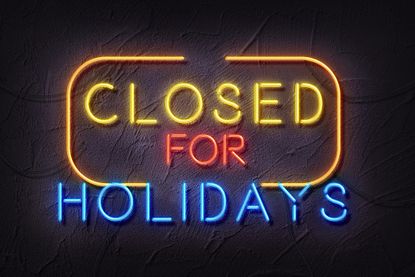Stock Market Holidays in 2024: NYSE, NASDAQ and Wall Street Holidays
When are the stock market holidays? Take a look at which days the NYSE, Nasdaq and bond markets are off in 2024.


What are the stock market holidays for 2024? You can answer the question of when is the stock market open or closed at any point throughout 2024 with our handy guide to the schedule of stock market and bond market holidays across the remainder of this year.
The list of stock market holidays actually grew by one in 2022, after Congress voted the year prior to make Juneteenth — the June 19 holiday commemorating the end of slavery — the 11th federal holiday. When President Joe Biden signed the bill, Juneteenth became the first new federal holiday since Martin Luther King, Jr. Day., which was signed into law in 1983.
Stock market holiday schedule
The NYSE and Nasdaq typically observe 10 stock market holidays each year. Those holidays are:

Sign up for Kiplinger’s Free E-Newsletters
Profit and prosper with the best of expert advice on investing, taxes, retirement, personal finance and more - straight to your e-mail.
Profit and prosper with the best of expert advice - straight to your e-mail.
- New Year's Day – Monday, January 1
- Martin Luther King, Jr. Day – Monday, January 15
- Presidents' Day – Monday, February 19
- Good Friday – Friday, March 29
- Memorial Day – Monday, May 27
- Juneteenth – Wednesday, June 19
- Independence Day – Thursday, July 4
- Labor Day – Monday, September 2
- Thanksgiving Day – Thursday, November 28
- Christmas Day – Wednesday, December 25
However, in certain circumstances, the stock market will close early in the days preceding or following market holidays. For instance the NYSE and Nasdaq close at 1 pm the day after Thanksgiving, on Christmas Eve (if it falls on a weekday) and on July 3 (if both it and July 4 fall on a weekday).
Below, you'll find the full stock market holiday schedule for 2024.
2024 Stock Market Holidays
| Date | Holiday | NYSE | Nasdaq |
|---|---|---|---|
| Monday, January 1 | New Year's Day | Closed | Closed |
| Monday, January 15 | Martin Luther King, Jr. Day | Closed | Closed |
| Monday, February 19 | Presidents' Day/Washington's Birthday | Closed | Closed |
| Thursday, March 28 | Maundy Thursday | Open | Open |
| Friday, March 29 | Good Friday | Closed | Closed |
| Friday, May 24 | Friday Before Memorial Day | Open | Open |
| Monday, May 27 | Memorial Day | Closed | Closed |
| Wednesday, June 19 | Juneteenth National Independence Day | Closed | Closed |
| Wednesday, July 3 | Monday Before Independence Day | Early close (1 pm) | Early close (1 pm) |
| Thursday, July 4 | Independence Day | Closed | Closed |
| Monday, September 2 | Labor Day | Closed | Closed |
| Monday, October 14 | Columbus Day/Indigenous Peoples' Day | Open | Open |
| Monday, November 11 | Veterans Day | Open | Open |
| Thursday, November 28 | Thanksgiving Day | Closed | Closed |
| Friday, November 29 | Day After Thanksgiving/Black Friday | Early close (1 pm) | Early close (1 pm) |
| Thursday, December 24 | Christmas Eve | Early close (1 pm) | Early close (1 pm) |
| Wednesday, December 25 | Christmas Day | Closed | Closed |
| Tuesday, December 31 | New Year's Eve | Open | Open |
Bond market holiday schedule
The bond markets observe the same 10 stock market holidays, as well as two additional holidays:
- Columbus Day – Monday, October 14
- Veterans Day – Monday, November 11
The bond markets also observe several early closings at 2 pm each year:
- The Thursday before Good Friday – Thursday, March 28
- The Friday before Memorial Day – Friday, May 24
- The day preceding Independence Day – Wednesday, July 3
- Black Friday, or the day after Thanksgiving – Friday, November 29
- Christmas Eve – Thursday, December 24
- New Year's Eve – Tuesday, December 31
Here is the full bond market holiday schedule for 2024:
2024 Bond Market Holidays
| Date | Holiday | Bond Markets* |
|---|---|---|
| Monday, January 1 | New Year's Day | Closed |
| Monday, January 15 | Martin Luther King, Jr. Day | Closed |
| Monday, February 19 | Presidents' Day/Washington's Birthday | Closed |
| Thursday, March 28 | Maundy Thursday | Early close (2 pm) |
| Friday, March 29 | Good Friday | Closed |
| Friday, May 24 | Friday Before Memorial Day | Early close (2 pm) |
| Monday, May 27 | Memorial Day | Closed |
| Wednesday, June 19 | Juneteenth National Independence Day | Closed |
| Wednesday, July 3 | Monday Before Independence Day | Early close (2 pm) |
| Thursday, July 4 | Independence Day | Closed |
| Monday, September 2 | Labor Day | Closed |
| Monday, October 14 | Columbus Day/Indigenous Peoples' Day | Closed |
| Monday, November 11 | Veterans Day | Closed |
| Thursday, November 28 | Thanksgiving Day | Closed |
| Friday, November 29 | Day After Thanksgiving/Black Friday | Early close (2 pm) |
| Thursday, December 24 | Christmas Eve | Early close (2 pm) |
| Wednesday, December 25 | Christmas Day | Closed |
| Tuesday, December 31 | New Year's Eve | Early close (2 pm) |
When it comes to the stock and bond markets alike, if a holiday falls on a weekend, market closures are dictated by two rules:
- If the holiday falls on a Saturday, the market will close on the preceding Friday.
- If the holiday falls on a Sunday, the market will close on the subsequent Monday.
Stock and bond market hours
For those wanting answers to other questions, like what time does the market open, regular stock market trading hours for the New York Stock Exchange (NYSE) and Nasdaq Stock Market are 9:30 am to 4 pm on weekdays. Bond markets usually trade between 8 am and 5 pm.
The stock markets close at 1 pm on early closure days. Bond markets close early at 2 pm. (All times Eastern unless otherwise indicated.)
Many folks might wonder why the stock market offers such limited hours when there are certainly people who want to buy and sell at all times of the day. One of the main reasons for this is "liquidity," which is how much buying and selling is going on at a given time.
The more liquidity in a particular security, the likelier you are to get a fair price on it; the less liquidity, the more likely you might have to settle for a less-than-ideal price to finish off a transaction.
"For the market to function effectively, you need buyers and sellers," says Charles Sizemore, principal of Sizemore Capital Management. "This is why the stock market has set hours that happen to correspond to the East Coast workday. You want the maximum number of traders buying and selling at the same time.
If you were at an estate auction selling your grandmother's antiques, you'd want a lot of bidders there. It's the same rationale in the stock market."
And there is trading that is done outside of these regular hours. On days with a regular session, for instance, there is "pre-market" trading. This occurs before the market, and while hours vary, they can extend as early as 4 am and run until the opening bell rings at 9:30 am. There is also "after-hours" trading, which happens after the market closes and typically runs from 4 pm to 8 pm.
But just because you can trade outside of regular stock market trading hours doesn't necessarily mean you should. Investors should be aware that volume and liquidity tend to be lower in pre-market and after-hours trading.
Temporary market stoppages
The stock market rarely closes unexpectedly, but so-called circuit breakers do occasionally trigger temporary trading halts.
Circuit breakers were first introduced after the Black Monday crash of October 1987. The Dow dropped almost 23% in a single session, which stands as a record to this day.
Circuit breakers are intended to curb panic selling. Like calling a timeout in sports, a temporary pause in trading allows market participants to catch their breath, though it doesn't necessarily keep stocks from declining once trading resumes.
There are three levels of circuit breakers tied to how steeply the market declines:
- A Level 1 market-wide circuit breaker is tripped if the S&P 500 falls 7% from its previous close.
- A Level 2 circuit breaker comes into effect when the market plunges 13%.
- A Level 3 circuit breaker kicks in if the market tanks 20%.
A Level 1 or Level 2 breach halts trading for a minimum of 15 minutes. A Level 3 rout halts trading for the remainder of the trading day.
Level 1 and Level 2 circuit breakers can be triggered between 9:30 am and 3:25 pm. A Level 3 breach can be triggered at any time.
Extraordinary stock market closures
The market has also shut down a smattering of times throughout history following catastrophic events. The attacks on the World Trade Center and Pentagon prevented the market from opening on September 11, 2001, and the exchanges remained shut until September 17.
Prior to that, you have to go back to World War I for an example of the stock market shutting down. The outbreak of hostilities in Europe led The New York Stock Exchange to close up shop from July 31 to November 28, 1914.
The market went dark only two other times in its history. The NYSE closed for 10 days during the Panic of 1873; and it took a week off trading to mourn the assassination of President Abraham Lincoln in 1865.
Additionally, markets will typically close when a former president dies. They most recently closed in December 2018 for the funeral of former President George H. W. Bush.
Data provided by the NYSE and SIFMA.
Related content
- Kiplinger's Earnings Calendar for This Week
- When Is the Next Fed Meeting?
- When Is the Next CPI Report?
Kyle Woodley is the Editor-in-Chief of WealthUp, a site dedicated to improving the personal finances and financial literacy of people of all ages. He also writes the weekly The Weekend Tea newsletter, which covers both news and analysis about spending, saving, investing, the economy and more.
Kyle was previously the Senior Investing Editor for Kiplinger.com, and the Managing Editor for InvestorPlace.com before that. His work has appeared in several outlets, including Yahoo! Finance, MSN Money, Barchart, The Globe & Mail and the Nasdaq. He also has appeared as a guest on Fox Business Network and Money Radio, among other shows and podcasts, and he has been quoted in several outlets, including MarketWatch, Vice and Univision. He is a proud graduate of The Ohio State University, where he earned a BA in journalism.
You can check out his thoughts on the markets (and more) at @KyleWoodley.
-
 Stock Market Today: Nasdaq Spirals as Netflix Nosedives
Stock Market Today: Nasdaq Spirals as Netflix NosedivesA big earnings boom for credit card giant American Express helped the Dow notch another win.
By Karee Venema Published
-
 Get These 40 Earth Day Deals and Discounts
Get These 40 Earth Day Deals and DiscountsMonday, April 22, is Earth Day. Many of your favorite retailers are celebrating with deals on sustainable products, recycling services, and more
By Kathryn Pomroy Published
-
 Stock Market Today: Nasdaq Spirals as Netflix Nosedives
Stock Market Today: Nasdaq Spirals as Netflix NosedivesA big earnings boom for credit card giant American Express helped the Dow notch another win.
By Karee Venema Published
-
 Stock Market Today: S&P 500, Nasdaq Extend Losing Streaks
Stock Market Today: S&P 500, Nasdaq Extend Losing StreaksThe two indexes have closed lower for five straight sessions.
By Karee Venema Published
-
 Stock Market Today: Dow Slips After Travelers' Earnings Miss
Stock Market Today: Dow Slips After Travelers' Earnings MissThe property and casualty insurer posted a bottom-line miss as catastrophe losses spiked.
By Karee Venema Published
-
 Stock Market Today: Stocks Stabilize After Powell's Rate-Cut Warning
Stock Market Today: Stocks Stabilize After Powell's Rate-Cut WarningThe main indexes temporarily tumbled after Fed Chair Powell said interest rates could stay higher for longer.
By Karee Venema Published
-
 Stock Market Today: Stocks Reverse Lower as Treasury Yields Spike
Stock Market Today: Stocks Reverse Lower as Treasury Yields SpikeA good-news-is-bad-news retail sales report lowered rate-cut expectations and caused government bond yields to surge.
By Karee Venema Last updated
-
 Stock Market Today: Nasdaq Leads as Magnificent 7 Stocks Rise
Stock Market Today: Nasdaq Leads as Magnificent 7 Stocks RiseStrength in several mega-cap tech and communication services stocks kept the main indexes higher Thursday.
By Karee Venema Published
-
 Stock Market Today: Stocks Tumble After a Hot Inflation Print
Stock Market Today: Stocks Tumble After a Hot Inflation PrintEquities retreated after inflation data called the Fed's rate-cut plans into question.
By Dan Burrows Published
-
 Stock Market Today: Stocks End Mixed Ahead of Key Inflation Reading
Stock Market Today: Stocks End Mixed Ahead of Key Inflation ReadingEquities struggled before tomorrow's big Consumer Price Index report.
By Dan Burrows Published